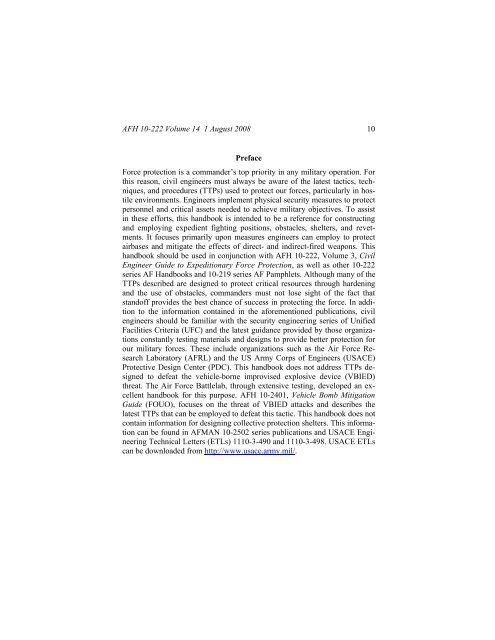Civil engineer guide to fighting positions, shelters, obstacles
Civil engineer guide to fighting positions, shelters, obstacles
Civil engineer guide to fighting positions, shelters, obstacles
You also want an ePaper? Increase the reach of your titles
YUMPU automatically turns print PDFs into web optimized ePapers that Google loves.
AFH 10-222 Volume 14 1 August 2008 10<br />
Preface<br />
Force protection is a commander’s <strong>to</strong>p priority in any military operation. For<br />
this reason, civil <strong>engineer</strong>s must always be aware of the latest tactics, techniques,<br />
and procedures (TTPs) used <strong>to</strong> protect our forces, particularly in hostile<br />
environments. Engineers implement physical security measures <strong>to</strong> protect<br />
personnel and critical assets needed <strong>to</strong> achieve military objectives. To assist<br />
in these efforts, this handbook is intended <strong>to</strong> be a reference for constructing<br />
and employing expedient <strong>fighting</strong> <strong>positions</strong>, <strong>obstacles</strong>, <strong>shelters</strong>, and revetments.<br />
It focuses primarily upon measures <strong>engineer</strong>s can employ <strong>to</strong> protect<br />
airbases and mitigate the effects of direct- and indirect-fired weapons. This<br />
handbook should be used in conjunction with AFH 10-222, Volume 3, <strong>Civil</strong><br />
Engineer Guide <strong>to</strong> Expeditionary Force Protection, as well as other 10-222<br />
series AF Handbooks and 10-219 series AF Pamphlets. Although many of the<br />
TTPs described are designed <strong>to</strong> protect critical resources through hardening<br />
and the use of <strong>obstacles</strong>, commanders must not lose sight of the fact that<br />
standoff provides the best chance of success in protecting the force. In addition<br />
<strong>to</strong> the information contained in the aforementioned publications, civil<br />
<strong>engineer</strong>s should be familiar with the security <strong>engineer</strong>ing series of Unified<br />
Facilities Criteria (UFC) and the latest guidance provided by those organizations<br />
constantly testing materials and designs <strong>to</strong> provide better protection for<br />
our military forces. These include organizations such as the Air Force Research<br />
Labora<strong>to</strong>ry (AFRL) and the US Army Corps of Engineers (USACE)<br />
Protective Design Center (PDC). This handbook does not address TTPs designed<br />
<strong>to</strong> defeat the vehicle-borne improvised explosive device (VBIED)<br />
threat. The Air Force Battlelab, through extensive testing, developed an excellent<br />
handbook for this purpose. AFH 10-2401, Vehicle Bomb Mitigation<br />
Guide (FOUO), focuses on the threat of VBIED attacks and describes the<br />
latest TTPs that can be employed <strong>to</strong> defeat this tactic. This handbook does not<br />
contain information for designing collective protection <strong>shelters</strong>. This information<br />
can be found in AFMAN 10-2502 series publications and USACE Engineering<br />
Technical Letters (ETLs) 1110-3-490 and 1110-3-498. USACE ETLs<br />
can be downloaded from http://www.usace.army.mil/.
















